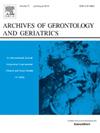BEHAVIORAL DISTURBANCES IN ALZHEIMER’S DISEASE: A NON-PHARMACOLOGICAL THERAPEUTIC APPROACH
IF 3.5
3区 医学
Q2 GERIATRICS & GERONTOLOGY
引用次数: 0
阿尔茨海默病的行为障碍:一种非药物治疗方法
痴呆患者的行为障碍是入院的主要原因之一。尽管大多数作者同意这些症状在非药物支持下得到很好的控制,但几乎所有的研究都集中在对症药物治疗上(典型或非典型抗精神病药)。我们研究的目的是评估阿尔茨海默病经验行为病理学(e- behavior -AD)测试显示的阿尔茨海默病患者的精神症状的减少,这些患者的护理人员接受了培训,学习了与家庭成员使用的各种沟通策略。我们评估了35例AD患者(男性18例,女性17例,平均年龄76.5±5.9岁)。在这些患者中,18例(男9例,女9例,平均年龄75.1±6.5岁)是护理者的亲属,他们接受了6个月的培训,4次小组会议和2次个人会议。在培训期间,护理人员了解了与AD患者沟通的可能性。他们被教导如何在疾病的各个阶段与阿尔茨海默病患者互动,以及如何有效地利用语言和非语言语言。其余17例患者(男9例,女8例,平均年龄76.1±4.9岁)作为对照组。观察期间,所有患者均给予利瓦斯汀或多奈哌。两组在年龄、性别、抗精神病药物治疗、最小精神状态检查(MMSE)、日常生活活动(ADL)、日常生活工具性活动(IADL)和e- behavior - ad的初始得分均相同。六个月后,我们用类似的一系列测试对患者进行评估。数据的分析从检验被试和对照组的同质性开始,对非配对数据进行t检验。采用chi2统计方法比较被试与对照组的定性变量。对于所有的统计检验,p < 0.05被认为是显著的。在有护理人员接受培训的患者组中,6个月后e- behavior - ad评分有统计学意义的显著下降(p < 0.001)(7.7比10.5;P < 0.001)。ADL、IADL和MMSE评分差异无统计学意义(ADL 4.7 vs. 4.3, p = 0.09;IADL 3.2 vs. 3.1, p =0.4;MMSE为17.3比15.1,p = 0.1)。文献中的大量证据强调了语言缺陷在痴呆症,特别是阿尔茨海默氏症中的中心地位。即使是部分地重建阿尔茨海默病患者和医生之间以及患者和护理人员之间的沟通渠道,也可以减少阿尔茨海默病患者行为障碍的频率和强度。
本文章由计算机程序翻译,如有差异,请以英文原文为准。
求助全文
约1分钟内获得全文
求助全文
来源期刊
CiteScore
7.30
自引率
5.00%
发文量
198
审稿时长
16 days
期刊介绍:
Archives of Gerontology and Geriatrics provides a medium for the publication of papers from the fields of experimental gerontology and clinical and social geriatrics. The principal aim of the journal is to facilitate the exchange of information between specialists in these three fields of gerontological research. Experimental papers dealing with the basic mechanisms of aging at molecular, cellular, tissue or organ levels will be published.
Clinical papers will be accepted if they provide sufficiently new information or are of fundamental importance for the knowledge of human aging. Purely descriptive clinical papers will be accepted only if the results permit further interpretation. Papers dealing with anti-aging pharmacological preparations in humans are welcome. Papers on the social aspects of geriatrics will be accepted if they are of general interest regarding the epidemiology of aging and the efficiency and working methods of the social organizations for the health care of the elderly.

 求助内容:
求助内容: 应助结果提醒方式:
应助结果提醒方式:


